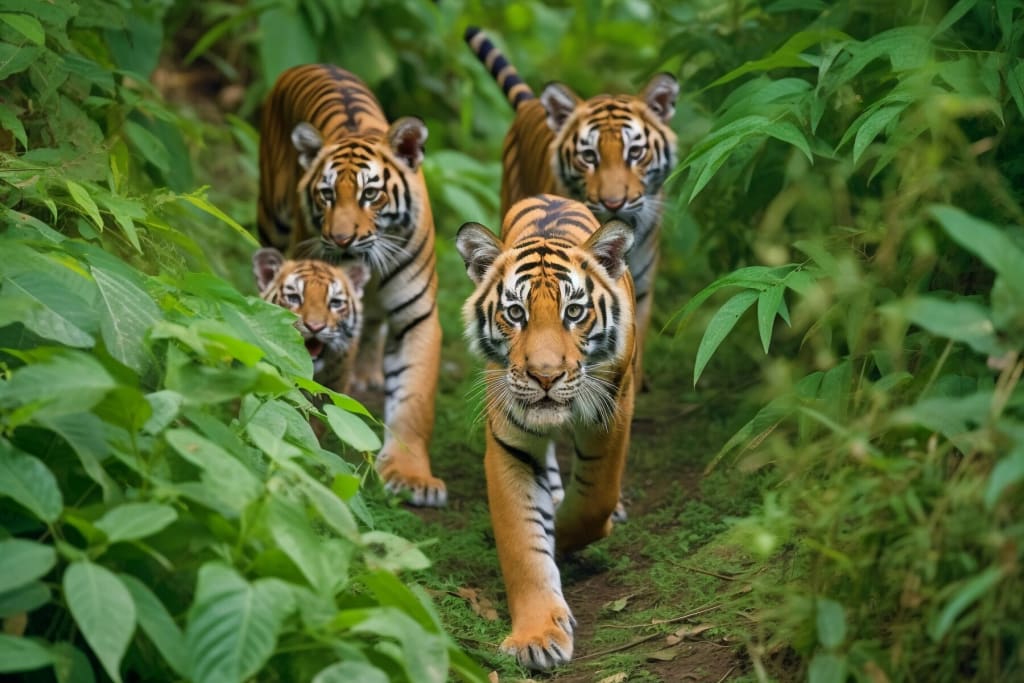The Wonders of Natural life: Investigating the World's Different Environment.
Wildlife

Presentation
Natural life comprises a fundamental part of our planet's biological equilibrium, assuming a vital part in keeping up with the wellbeing and maintainability of our current circumstance. From the grand African savannas to the lavish Amazon rainforests, the frigid domains of the Cold to the huge profundities of the seas, untamed life is a many-sided trap of life that backings and sustains endless species, including people. This article dives into the intriguing universe of untamed life, inspecting its different territories, the meaning of biodiversity, the difficulties looked by natural life, and the endeavors being made to secure and ration our planet's regular legacy.
The Variety of Natural life Environments
1. Tropical Rainforests
Tropical rainforests, frequently alluded to as the "lungs of the Earth," are home to the most extravagant biodiversity on earth. These thick, lavish backwoods cover just around 6% of the World's surface yet house more than half of its plant and creature species. The Amazon Bowl, the Congo Bowl, and Southeast Asian rainforests are great representations of such environments.
In the Amazon rainforest, the assorted cluster of species incorporates the puma, wench falcon, and toxic substance dart frog. The complicated design of the rainforest, with its various layers from the timberland floor to the overhang, makes various specialties that help a wide assortment of living things. This biodiversity is indispensable for biological cycles like fertilization, seed dispersal, and carbon stockpiling.
2. Savannas
Savannas are meadow biological systems portrayed by open scenes with dissipated trees. These environments are prevalently tracked down in Africa, Australia, and South America. The African savanna, home to notorious species like lions, elephants, and giraffes, is perhaps of the most notable model.
The connection among herbivores and carnivores in the savanna makes a unique equilibrium that keeps up with the soundness of the environment. Herbivores, like zebras and wildebeests, eat on the grasses, while hunters, like lions and cheetahs, hold the herbivore populaces under tight restraints. This equilibrium guarantees the supportability of the meadow and forestalls overgrazing.
3. Deserts
Deserts are bone-dry districts with outrageous temperature changes and scant precipitation. In spite of these cruel circumstances, deserts are home to an exceptional cluster of untamed life adjusted to make due in such conditions. The Sahara Desert, the Mojave Desert, and the Australian Outback are instances of desert biological systems.
In the Sahara, species, for example, the fennec fox, dromedary camel, and different reptiles have advanced to flourish in the extreme intensity and restricted water accessibility. These creatures display transformations like nighttime conduct, water protection systems, and specific eating regimens that empower them to get through the desert's difficulties.
4. Seas
Seas cover over 70% of the World's surface and harbor a staggering variety of life. From coral reefs to remote ocean channels, marine biological systems are overflowing with species that assume basic parts in worldwide natural cycles.
Coral reefs, frequently called the "rainforests of the ocean," are among the most different marine living spaces. They support a variety of species, including vivid fish, ocean turtles, and marine spineless creatures. The soundness of coral reefs is fundamental for waterfront security, fisheries, and the travel industry. Nonetheless, these environments are profoundly defenseless against environmental change and human exercises.
The Significance of Biodiversity
Biodiversity, the assortment of life in the entirety of its structures, levels, and mixes, is fundamental for the strength and flexibility of environments. High biodiversity guarantees that environments can endure and recuperate from unsettling influences, like catastrophic events and human effects. It additionally gives various environment benefits that are fundamental for human endurance and prosperity.
1. Biological system Administrations
Biological system administrations are the advantages that people get from nature. These administrations incorporate provisioning administrations (like food, water, and unrefined substances), managing administrations, (for example, environment guideline and infectious prevention), supporting administrations (like supplement cycling and soil development), and social administrations (like amusement and otherworldly worth).
Backwoods, for instance, assume a urgent part in carbon sequestration, assisting with relieving environmental change by engrossing carbon dioxide from the air. Wetlands go about as normal water channels, cleaning water and diminishing the gamble of floods. Pollinators, like honey bees and butterflies, are fundamental for crop creation, adding to food security.
2. Hereditary Variety
Hereditary variety inside species is significant for their versatility and endurance. It permits populaces to adjust to changing natural circumstances and oppose sicknesses. A hereditarily different populace is bound to have people with characteristics that can assist them with making due in new or testing conditions.
For example, the hereditary variety of harvest species is essential for horticulture. It empowers reproducers to foster new assortments that are impervious to irritations, illnesses, and changing environment conditions. The deficiency of hereditary variety in wild populaces can make species more helpless against eradication.
3. Social and Tasteful Worth
Untamed life and regular scenes have critical social and tasteful worth. They rouse workmanship, writing, and customs across societies. Numerous native networks have profound otherworldly associations with the land and its untamed life, seeing them as indispensable to their personality and lifestyle.
Public stops and safeguarded regions, which protect normal territories and untamed life, give open doors to diversion and the travel industry. These regions offer individuals an opportunity to interface with nature, experience its excellence, and gain a more noteworthy appreciation for the regular world.
Dangers to Untamed life
Regardless of its significance, natural life faces various dangers from human exercises. These dangers have prompted critical decreases in natural life populaces and the corruption of biological systems.
1. Environment Annihilation
Environment annihilation is one of the main dangers to untamed life. It happens when regular environments are changed over for horticulture, metropolitan turn of events, foundation, and other human purposes. Deforestation, wetland seepage, and land change are normal types of environment annihilation.
In the Amazon rainforest, huge scope deforestation for dairy cattle farming, soy development, and logging has prompted the deficiency of basic territories for endless species. Territory fracture, where huge environments are partitioned into more modest, confined patches, further intensifies the issue by restricting species' capacity to move and track down assets.
2. Environmental Change
Environmental change is modifying the World's environment designs, prompting shifts in temperature, precipitation, and climate limits. These progressions are affecting natural life in different ways, including adjusting living spaces, upsetting movement designs, and influencing the accessibility of food and water.
Polar bears in the Icy, for instance, are battling as ocean ice softens prior and structures later every year, decreasing their admittance to hunting grounds. Coral reefs are encountering far and wide dying occasions because of climbing ocean temperatures, prompting the deficiency of biodiversity and the debasement of reef biological systems.
3. Contamination
Contamination from modern exercises, agribusiness, and metropolitan regions is sullying air, water, and soil, presenting serious dangers to natural life. Synthetic substances like pesticides, weighty metals, and plastics can aggregate in the climate and damage creatures at all levels of the pecking order.
Marine contamination, especially from plastic waste, has turned into a worldwide emergency. Marine creatures, for example, ocean turtles, seabirds, and marine vertebrates, frequently botch plastic trash for food, prompting ingestion, ensnarement, and demise. Contaminations can likewise bioaccumulate in the tissues of creatures, prompting long haul wellbeing impacts.
4. Overexploitation
Overexploitation alludes to the impractical utilization of natural life assets for purposes like hunting, fishing, logging, and exchange. Overfishing, unlawful untamed life exchange, and poaching are significant drivers of species decline.
The African elephant populace has been seriously impacted by poaching for ivory, while overfishing has prompted the consumption of many fish stocks around the world. Impractical logging rehearses in tropical timberlands obliterate territories as well as compromise species that rely upon these backwoods for endurance.
5. Intrusive Species
Intrusive species are non-local species that are acquainted with new conditions, frequently by human exercises, and actually hurt local species and environments. Obtrusive species can outcompete, go after, or spread sicknesses to local species, prompting declines or eradications.
The presentation of the earthy colored tree snake to Guam, for instance, has prompted the decay of local bird populaces on the island. Intrusive plant species can likewise modify territories by uprooting local vegetation and changing biological system elements.
Protection Endeavors
Notwithstanding the difficulties, various endeavors are being made to secure and save untamed life and their territories. Preservation systems envelop a scope of approaches, from safeguarded regions and regulation to local area inclusion and global participation.
1. Safeguarded Regions
Laying out safeguarded regions, for example, public parks, untamed life stores, and marine safeguarded regions, is a principal procedure for monitoring biodiversity. These regions give places of refuge to untamed life, where they are protected from human exercises and can flourish in their normal natural surroundings.
The Serengeti Public Park in Tanzania and the Incomparable Boundary Reef Marine Park in Australia are instances of safeguarded regions that shield basic environments and species. Powerful administration and implementation are fundamental to guarantee the outcome of safeguarded regions in moderating biodiversity. 2. Regulation and Arrangements
Regulation and strategies at nearby, public, and worldwide levels assume a vital part in untamed life preservation. Regulations, for example, the Jeopardized Species Act in the US and the Show on Global Exchange Imperiled Types of Wild Fauna and Greenery (Refers to) plan to safeguard compromised species and direct the exchange of untamed life items.
Peaceful accords, for example, the Paris Settlement on environmental change, additionally have huge ramifications for natural life protection. By tending to the main drivers of environmental change, these arrangements add to the security of biological systems and species impacted by changing environment conditions.
3. Local area Association
Connecting with nearby networks in preservation endeavors is fundamental for the achievement and manageability of these drives. Local area based preservation approaches perceive the significance of neighborhood information, customs, and vocations in safeguarding natural life.
In numerous districts, native and nearby networks have laid out preservation regions and carried out supportable practices that benefit both natural life and individuals
About the Creator
Enjoyed the story? Support the Creator.
Subscribe for free to receive all their stories in your feed. You could also pledge your support or give them a one-off tip, letting them know you appreciate their work.
Reader insights
Outstanding
Excellent work. Looking forward to reading more!
Top insight
Excellent storytelling
Original narrative & well developed characters






Comments (1)
beautifully written